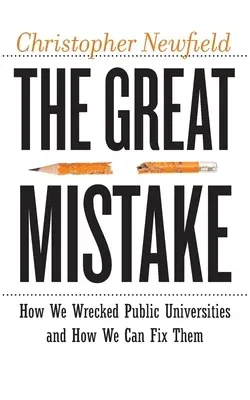A remarkable indictment of how misguided business policies have
undermined the American higher education system.
Winner of the CHOICE Outstanding Academic Title of the Choice ACRL
Higher education in America, still thought to be the world leader, is in
crisis. University students are falling behind their international peers
in attainment, while suffering from unprecedented student debt. For over
a decade, the realm of American higher education has been wracked with
self-doubt and mutual recrimination, with no clear solutions on the
horizon. How did this happen? In this stunning new book, Christopher
Newfield offers readers an in-depth analysis of the "great mistake" that
led to the cycle of decline and dissolution, a mistake that impacts
every public college and university in America. What might occur, he
asserts, is no less than locked-in economic inequality and the fall of
the middle class.
In The Great Mistake, Newfield asks how we can fix higher education,
given the damage done by private-sector models. The current accepted
wisdom--that to succeed, universities should be more like businesses--is
dead wrong. Newfield combines firsthand experience with expert analysis
to show that private funding and private-sector methods cannot replace
public funding or improve efficiency, arguing that business-minded
practices have increased costs and gravely damaged the university's
value to society.
It is imperative that universities move beyond the destructive policies
that have led them to destabilize their finances, raise tuition,
overbuild facilities, create a national student debt crisis, and lower
educational quality. Laying out an interconnected cycle of mistakes,
from subsidizing the private sector to "the poor get poorer" funding
policies, Newfield clearly demonstrates how decisions made in
government, in the corporate world, and at colleges themselves
contribute to the dismantling of once-great public higher education. A
powerful, hopeful critique of the unnecessary death spiral of higher
education, The Great Mistake is essential reading for those who wonder
why students have been paying more to get less and for everyone who
cares about the role the higher education system plays in improving the
lives of average Americans.

